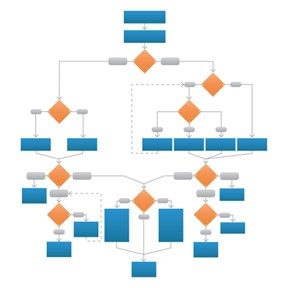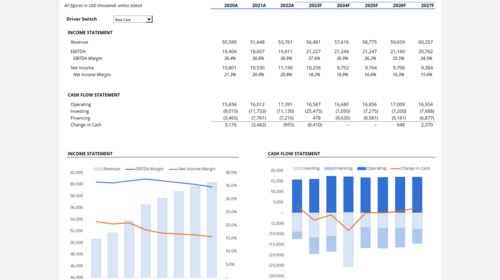- What is Total Quality Management?
- How Does Total Quality Management (TQM) Work?
- The Key Players in Total Quality Management: Customers, Suppliers, and Employees
- Implementing TQM Principles and Processes
- History of Total Quality Management
- What are the Principles of Total Quality Management (TQM)?
- Customer Focus
- Leadership Commitment
- Employee Involvement
- Process-Oriented Approach
- Continuous Improvement
- Evidence-based Decision Making
- Supplier Relationships
- The Seven Basic Tools of Total Quality Management
- Examples of Total Quality Management in Action
Total Quality Management (TQM)
A comprehensive approach to organizational management that emphasizes the continual pursuit of quality and operational excellence
What is Total Quality Management?

A commonly known quality management approach is Total Quality Management (TQM). This philosophical approach focuses on leading and achieving quality excellence in every aspect of an organization. It emphasizes continuous improvement, involving all employees in the pursuit of customer satisfaction.
TQM fosters a culture where quality is ingrained, encouraging teamwork, proactive problem-solving, and a commitment to excellence. By integrating quality into all processes and departments, TQM aims to eliminate defects, streamline operations, reduce waste, and enhance overall performance, ensuring long-term success and competitiveness in the market.
Key Highlights
- Total Quality Management (TQM) emphasizes continuous improvement, involving all employees in achieving quality excellence. It fosters a culture of ingrained quality, teamwork, proactive problem-solving, and commitment to excellence, aiming to eliminate defects, reduce waste, and enhance overall performance.
- TQM focuses on customer satisfaction, employee involvement, process-oriented approaches, continuous improvement, evidence-based decision-making, supplier relationships, and leadership commitment to drive a culture of quality excellence.
- TQM requires strong leadership commitment, systematic processes, and employee engagement. Real-world examples like Toyota Production System (TPS), Motorola’s Six Sigma, and healthcare sector applications illustrate TQM’s impact on quality enhancement in various industries.
How Does Total Quality Management (TQM) Work?
Total Quality Management involves continuous improvement, leveraging data and metrics to make informed decisions, fostering a culture of teamwork and innovation, and aligning strategies with customer needs. Among the primary TQM principles is customer satisfaction – in other words, meeting and exceeding customer needs.
Quality is integral in every aspect of operations, with the goal of striving for excellence in products, services, and internal processes while adapting to evolving market demands. Satisfied customers is the outcome of such a quality-integrated system.
Related to TQM is the concept of Kaizen, a Japanese term for “continuous improvement.” This concept emphasizes incremental changes made by every employee. It’s ideal for organizations looking to instill a culture of constant, small-scale improvements. Kaizen encourages employee engagement, fosters creativity, and is effective in workplaces where innovation and adaptability are paramount.
The Key Players in Total Quality Management: Customers, Suppliers, and Employees
In Total Quality Management (TQM), customers, suppliers, and employees play pivotal roles as key stakeholders contributing to quality assurance and quality control in an organization.
Customer focus is central; customer satisfaction steers the direction of quality standards. Understanding the feedback they provide on-demand products, preferences, and experiences is fundamental to delivering products or services that surpass expectations.
Suppliers represent another critical element. They provide the raw materials and inputs necessary for a production process or insight into the planning phase of the overall manufacturing processes, directly impacting the quality of the final output. Collaborating closely with suppliers ensures consistency and reliability in the inputs, thus influencing the quality of the end product or service.
Employees must be on the same page as top management to properly apply total quality management tools. Examples include the integration of each production process as a holistic view of the overall manufacturing processes. The widely agreed-upon approach to TQM helps build integrated systems that foster customer satisfaction.
Empowering and engaging employees at all levels fosters a culture where everyone contributes ideas, innovation, and efforts toward achieving superior quality, ultimately benefiting the customers and the organization as a whole.
TQM processes are used to improve processes, instill an organizational commitment to quality assurance and quality control, and dedication to continuous improvement that materially drives customer satisfaction.
Implementing TQM Principles and Processes
Implementing TQM requires strong leadership commitment to drive cultural change. Clear objectives aligned with the organization’s mission and vision are set, and resources are allocated for training and skill development.
Total Quality Management involves engaging employees at all levels, with effective communication that fosters a sense of ownership and empowerment. It relies on systematic data collection and analysis (such as benchmarking) to foster feedback loops for evidence-based decision-making (also known as the Plan-Do-Act-Check cycle of Kaizen).
Engagement of people is another one of a handful of total quality management principles. Effective communication is vital, ensuring everyone understands their role in achieving quality goals, promoting transparency, and encouraging collaboration across departments.
History of Total Quality Management
Total Quality Management (TQM) originated in the early 20th century with statistical quality control methods in manufacturing. However, its systematic development gained prominence post-World War II.
A key influencer is Dr. W. Edwards Deming, who introduced principles focusing on statistical methods, process improvement, and employee involvement.
Japan notably embraced TQM in its post-war reconstruction era, propelling the nation’s economic resurgence by applying Deming’s principles. Japan’s success in quality and productivity spurred global interest in TQM during the 1980s.
Western countries implement total quality management in response to intense market competition. Alongside the economic shift beyond the manufacturing sector, the versatile approach was adopted in a variety of service sectors, such as healthcare.
Today, TQM is the foundation of many quality approaches, emphasizing customer-centricity, continual improvement, and organizational excellence, influencing operational strategies worldwide.
The American Society of Quality (ASQ) is an international organization sought by companies seeking to implement strong quality management systems. The international organization advocates for the ISO 9000 family of standards,
What are the Principles of Total Quality Management (TQM)?
Total Quality Management (TQM) encompasses a set of fundamental guidelines aimed at fostering a culture of quality excellence within an organization. The American Society of Quality (ASQ) outlines seven principles within their strategic and systematic approach (ISO 9000).
Customer Focus
Understanding, meeting, and exceeding customer expectations is at the core of TQM. With proper training, TQM focuses on an enduring organizational culture to anticipate and respond to customer input and feedback (i.e., customer satisfaction) as the key concept to remain competitive.
Leadership Commitment
Active management participation to demonstrate their dedication and involvement in championing quality management initiatives throughout the entire organization. To achieve success, the core values of delivering quality are inherent in TQM strategies.
Employee Involvement
Encourage and empower employees at all levels to contribute ideas and efforts in a continuous effort to achieve quality improvement. Total employee involvement integrates quality throughout the production cycle. Quality-related issues and other immediate process issues are addressed promptly.
Process-Oriented Approach
Emphasizing systematic and structured methods for achieving quality goals. The systematic approach to process improvements is customer-focused, with quality planning to improve service quality throughout the customer journey.
Continuous Improvement
The core component of TQM is the commitment to delivering quality and the continuous effort to improve the quality of products and services. TQM strives to achieve excellence and total quality control as part of the strategic plan of optimizing and improving processes.
Evidence-based Decision Making
Tools must collect and apply accurate data and rigorous analysis to drive informed decisions. Basic tools and organizational performance data used by TQM practices can span cross-functional teams.
Supplier Relationships
Supply chain management is a critical component of modern quality control. Companies collaborate closely with suppliers to ensure joint quality planning, from basic raw materials and inputs, as part of an integrated system of business processes and production processes.
These principles collectively aim to cultivate a culture where quality is everyone’s responsibility, striving for excellence and continuous advancement in all aspects of the organization to meet or exceed customer expectations.
The Seven Basic Tools of Total Quality Management
The American Society of Quality (ASQ) attributes attributes “the basic seven” tools of quality, sometimes known as 7 QC (Quality Control) tools, to Kaoru Ishikawa. These quality management tools are instrumental in analyzing data, identifying problems, understanding processes, and making informed decisions to improve quality within an organization.
Cause-and-Effect Diagrams (Fishbone or Ishikawa diagrams)
|
Visual tools to identify and analyze potential causes contributing to a specific problem or outcome. |
Check Sheets
|
Simple forms or charts to collect and organize data systematically, facilitating easy analysis. |
Control Charts
|
Statistical graphs monitor variations and track process stability over time, distinguishing between common causes and assignable causes of variations. |
Histograms
|
Common graph for data distribution, helping users identify variations and patterns in a dataset. |
Pareto Charts
|
Pareto distribution to display factors in descending order of frequency or impact, useful to highlight the most significant issues. |
Scatter Diagrams
|
A scatter plot visualizes the relationships between two variables to identify correlations or trends. |
Stratification / Flowcharts
|
Diagrams illustrating the sequence of steps or processes, aiding in understanding and optimizing workflows. |
Examples of Total Quality Management in Action
Toyota Production System (TPS) |
Often cited as a prime example of TQM, introduced by Toyota in 1961, it emphasizes continuous improvement, elimination of waste, and respect for people. It includes practices like Just-in-Time manufacturing and Kaizen (continuous improvement) to enhance quality and efficiency in manufacturing processes. |
Motorola’s Six Sigma |
Motorola developed the Six Sigma methodology in 1986. It is a quality management technique focused on reducing defects and variation in processes. This management system and approach to process thinking have been widely adopted by other industries to drive quality improvement |
Healthcare Sector |
Hospitals and healthcare institutions implement TQM principles to enhance patient care, reduce medical errors, and streamline processes. For example, using Lean Six Sigma methodologies improves efficiency in emergency room operations or in reducing patient waiting times. |
Related Resources
Thank you for reading CFI’s guide to Total Quality Management (TQM). To keep learning and developing your knowledge base, please explore the additional relevant resources below:
Create a free account to unlock this Template
Access and download collection of free Templates to help power your productivity and performance.
Already have an account? Log in
Supercharge your skills with Premium Templates
Take your learning and productivity to the next level with our Premium Templates.
Upgrading to a paid membership gives you access to our extensive collection of plug-and-play Templates designed to power your performance—as well as CFI's full course catalog and accredited Certification Programs.
Already have a Self-Study or Full-Immersion membership? Log in
Access Exclusive Templates
Gain unlimited access to more than 250 productivity Templates, CFI's full course catalog and accredited Certification Programs, hundreds of resources, expert reviews and support, the chance to work with real-world finance and research tools, and more.
Already have a Full-Immersion membership? Log in












